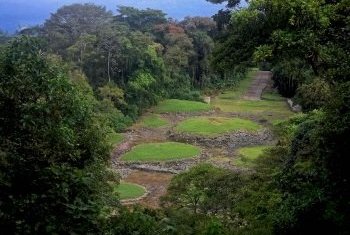Esteban Cervantes Jiménez
National archeological park of Guayabo de Turrialb
National archeological park of Guayabo de Turrialb (Removed from tentative list)

I would like to add a less general information to my initial account, made years ago. By that time, I hadn't visited the site in some 10 years.
I'm back on visiting different sites of Costa Rica and I made an almost incidental visit on Guayabo on October 12th (an unplanned homage to the initial contact between the native american and indigenous worlds). I did also a lot of photographing, which I hadn't done on my 2 or 3 previous visits. I think I got some really good shots. The area, not just the archaeological area, but the rural environment, the natural heritage, and the landscapes are worth photographing.
On the access, it's relatively easy for a country mostly covered by bus lines. By car, you have three possible routes. By bus, the two first options imply a 8 km-walk to the monument, on gravel road, that to be honest, I think that doesn't need a 4-wheel-traction, because it is in very good conditions, even in the middle of the rainy season. And the second, you get by bus right to the entrance of the park, but lose most of the charm that the other routes have.
The first route: You go from Cartago to Pacayas and Santa Cruz de Turrialba, then turn left 8 km and you get to the national monument. It's more mountainous and kind of windy, but you'll get a really good appreciation of what the traditional countryside is. Plus, you'll pass through enchanting towns (Cipreses, Pacayas, Capellades, La Pastora, Santa Cruz), each with its own set of declared heritage sites.
The second option is to take the main road from Cartago to Turrialba city and then go up to Santa Cruz, turn right and the 8 km to Guayabo.
The third option is to go to Turrialba city by the main road, continue north and then take the left detour to Colonia Guayabo.
The first one is the one I took, on the way there. It's remarkably lovely, we got by bus from Cartago, 1 hour more or less, but you have to walk from Santa Cruz to the monument, 8 kms, with some rises, and a final big descend. We made the walking in about 3 hours. I think that was the greatest part of the experience, for those like me, that like strolling, It's a great option. You can buy cheese or eat in Santa Cruz (the capital of costarrican cheese), pass near farms, see flowers in bloom, fresh rivers, pass by the house of late costarrican poet Jorge Debravo (who was from Guayabo Arriba), see the cone of the currently active Turrialba volcano and at the end, feel the forest that has retaken the area of the National Monument. The company that gives the bus service to Pacayas and Santa Cruz's name is Gemon and its telephone number is (506) 25373789.
The second route implies the 8 km walk as well. The third is serviced by a bus route, that gets to the entrance of the monument itself. The company's name is Autotransportes Rivera and here you'll find information about its service (http://www.costaricaexplorerguide.com/php/atracciones.php?atract=31). However, as it shows on this website, it's very few times a day, so you'll have to be at Turrialba at perfect timing to take the bus. Anyway, after visiting the monument, we took this bus to Turrialba at 4 pm (the monument closes between 3:30 and 4 pm).
After experiencing the rural surroundings, we visited in just over 1 hour and a half the main attractions of the monument. From the ticket stand (where you can also get a guide, that was really inexpensive), you can take two different routes.
I recommend to take the one on the left, that passes first by the "the Jaguar and the Crocodile Petroglyph", some tombs 'de cajón' and then, rise to the Viewpoint. The view (photo in the link) is breathtaking and you get a impression of what is the configuration of the archaeological remains. From there, you go down to the archaeological site, everything is well sign-posted and the road is marked. You see down there the mounds, the plazas, the functioning aqueduct, the tombs, the paved road or calzada and the two rectangular mounds that were used in precolumbian times to control the access .
Then, after passing a section of the forest, you get back to the ticket and information building. From there also starts a walk through the jungle, to appreciate the natural values of the site. However, on the contrary from the first trail, in the rainy season it is very muddy, we had to get back to where we started.
On the other side of the entrance, there are baths, a place for informational presentations, a campsite, places to eat (at the entrance, there are, by the way, people from the area, selling fruits and costarrican traditional dishes...this rounds up the whole experience), and a crafts shop. There you also take the bus to Turrialba.
In short, if you come to Costa Rica, I truly recommend to get to this site, whether by bus, bus and walk or car. The archaeological remains are really interesting and well taken care of, the jungle adds to its value, the road to Santa Cruz has wonderful landscapes and from there to Cartago, you get a true feel of what Costa Rica is about. A great one-day trip.
Comments
No comments yet.